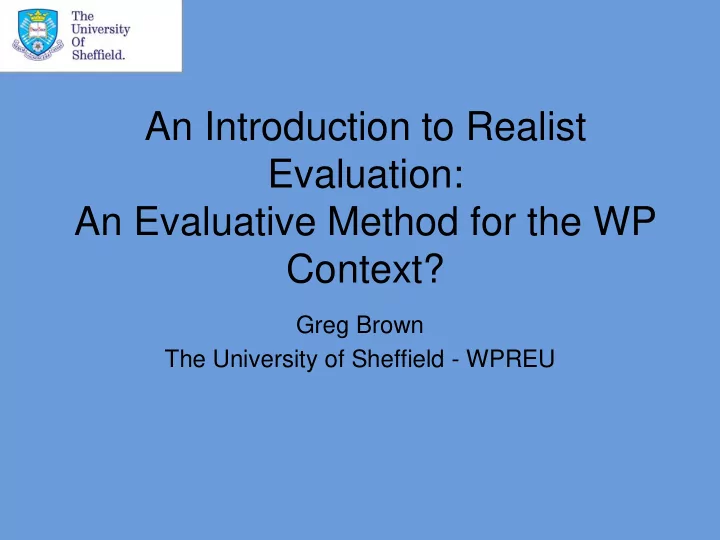

An Introduction to Realist Evaluation: An Evaluative Method for the WP Context? Greg Brown The University of Sheffield - WPREU
Major Works and Development
Basis in Evaluation • Theory-Driven Approach (Chen & Rossi 1983; 1990) • Scientific Realism (Bhaskar 1998) • Since been stated that ‘Realist Evaluation’ can be more accurately described as being based in ‘some kind of realism’ (Pawson 2013) Alkin & Christie (2004)’ Evaluation Tree: note Pawson and Tilley as a distinctive offshoot of the ‘methods’ trunk
Criticism of Experimental Evaluation • ‘Successionist’ causal logic • Is asking ‘does this work’ the right question? • Attribution concerns • Confounding factors • ‘Random allocation, or efforts to mimic it… represents an endeavor to cancel out differences.. This is absurd, it is an effort to write out what is essential to a program - social conditions favourable to its success.’ (Pawson and Tilley 1997: 52) • This lack of contextual consideration is what gives experimental evaluations their characteristically mixed results
A Move to a Generative Causal Logic in Evaluation • ‘Evaluators need to attend to how and why social programme have the potential to cause change’ (Pawson and Tilley 1997) • Basis in the physical sciences - regularity = mechanism + context • Firework analogy A realist experiment design which outlines the logic of generative causation (Pawson and Tilley 1997: 60)
What Works for Whom, in What Circumstances and Why?
The Realist Research Design • The realist research design begins with a phase of theory elicitation • Outcome = Mechanism + Context • “In other words, programs work (have successful outcomes) only in so far as they introduce the appropriate ideas and opportunities (mechanisms) to groups in the appropriate social and cultural conditions (contexts)” (Pawson and Tilley (1997: 57) • Contexts - always multiple, and are the pre-existing features of the localities in which interventions are introduced • Mechanisms - what it is about interventions that bring about any effects • Outcomes - intended and unintended consequences of interventions
The Realist Research Cycle (Pawson and Tilley 1997: 85)
Theory Testing and Refinement • VICTORE Checklist (Pawson 2013) • The ‘teacher - learner’ cycle • ‘Realist Interviews (Manzano 2016) • Method neutrality - choosing the appropriate methods for the particular evaluation or intervention • Iterative nature of data collection
Realist Forms of Cumulation • ‘Sadly, evaluation studies seem to be one - off affairs… they neither look back and build on previous evaluations or build towards future evaluations..’ (Pawson and Tilley 1997: 115) • Using CMO Configurations (CMOC’s) to deepen, specify and focus our understanding of CMO patterns • Cumulation in evaluation is thus about creating middle-range theory which are loose enough to interpret similarities and differences between families of programmes
A Fit For Widening Participation? • Embeddedness • Complexity • Provides us with greater clarity regarding the causal barriers to HE for WP students (through CMOC’s) • Using all stakeholders unique and often tacit knowledge • Eliciting, testing and refining ‘folk theories’ • Harrison and Waller (2016)
Example - Post 16 Pastoral E- mentoring intervention Outcomes: • Dissemination of relevant information from current to prospective students • Increased proportion of prospective students feeling confident about a move to HE/target University • Dissemination of helpful lived experience support and guidance • Prospective students feeling further estrangement from target University/HE What activities, tools and ideas (mechanisms) do outreach interventions use? • Proactive mentor checking in on mentee • Hands off mentor who lets mentee seek advice and assistance • Pairing mentors with mentees who are doing similar A-levels • Accessible online platform What pre-existing structures (context) enable or disable these mechanisms from ‘firing’ and producing beneficial outcomes? • Material contexts • Individual contexts • Levels of social and cultural capital
Conclusions • Theory driven approach, invoking generative causation • Developing hypothesis of how an intervention works for whom, in what circumstances and why (or not), expressed through formative CMO configurations • Using the appropriate methods to observe how the CMO’s interact, with an emphasis on the ‘teacher - learner cycle’ (realist interviews), thus refining and testing the theory • Developing ‘middle - range’ theories of how programmes work, for whom in what circumstances and why, allowing for cumulation across a family of associated interventions (CMOC’s)
References Alkin, M. & Christie, C., 2004. An evaluation theory tree. Evaluation roots: Tracing theorists’ views … , pp.12 – 65. Available at: http://books.google.com/books?hl=en&lr=&id=swDMkRzVCRIC&oi=fnd&pg=PA12&dq=An+evaluation+theory+tree&ots=jaLz ddRajD&sig=jkkjUumbEyfT9ZRFPIwzbL1j-rc. Bhaskar, R., (1998) Philosophy and Scientific Realism. Critical Realism: Essential Readings , pp.16 – 47. Chen, H., & Rossi, P. (1983). Evaluating with sense: The theory-driven approach. Evaluation Review, 7 , 283-302. Chen, H., & Rossi, P. (1990). Theory-Driven Evaluations . Thousand Oaks, CA: Sage. Manzano, A. (2016). ‘ The Craft of Interviewing in Realist Evaluation’ . Evaluation. 22 (2) pp.1-19 Pawson, R., (2013) First Principles: A Realist Diagnostic Workshop. In The Science of Evaluation - A Realist Manifesto . pp. 13 – 31. Pawson, R., (2013) A Complexity Checklist. In The Science of Evaluation - A Realist Manifesto . pp. 33 – 45. Pawson, R, Tilley, N. (1997) ‘Realistic Evaluation’ London, Sage
Thanks for Listening! • Any Questions? • Can you think of a WP intervention where a Realist approach could be beneficial? • How would you begin designing a Realist evaluation of this intervention? • In the time we have, start formulating CMO based programme theories, looking at what mechanisms may fire in what contexts?
Recommend
More recommend